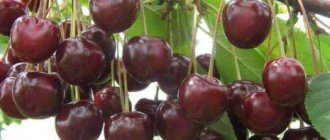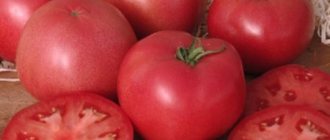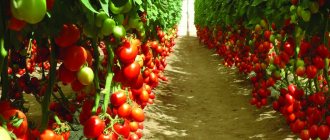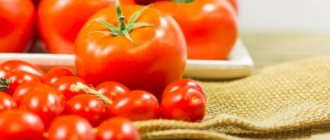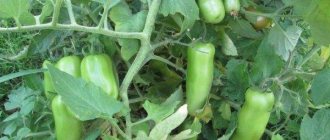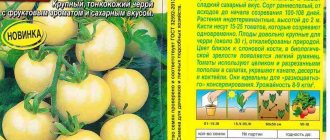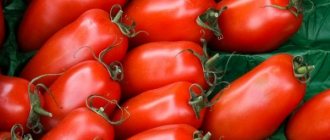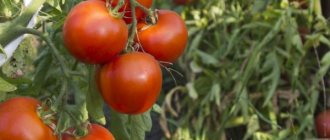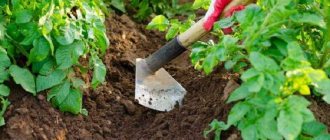Vegetable growing » Tomatoes
0
1208
Article rating
Kira Stoletova
The Yellow Cherry tomato is an ideal option for those individuals who like to collect a large harvest of produce. To achieve this goal, there is absolutely no need to plant a large number of bushes. A few pairs of bushes will be enough to get a large amount of produce. Breeders first developed this variety at the beginning of the 21st century.
Description of the tomato variety Cherry Yellow
Description and characteristics of the variety
Tomatoes Yellow Cherry from Gavrish are tall indeterminates. Average height is 2 meters or more. The variety is early ripening, from germination to ripening 95-100 days. The plant is powerful, the leaves are dense, slightly corrugated, dark green. The tomato is very leafy, the number of stepsons is small. The variety is intended for cultivation in open areas and in film greenhouses.
The taste of the fruit is highly dependent on the amount of heat, sunlight and nutrition.
The first inflorescences are simple, containing 15-20 tomatoes. The following are complex, branching; 30-40 small round tomatoes simultaneously develop on one brush. A ripe cherry cluster resembles a bunch of grapes, the fruits are small, 15-25 grams each. The skin is bright yellow, dense, and there is a lot of liquid content inside. Ripe tomatoes are sweet and juicy.
Agricultural technology
Seed preparation
The main condition for a good harvest is proper planting of seeds. First of all, prepare the soil from soil, peat and sand. All ingredients are mixed well and poured into prepared wooden or special store-bought boxes.
The seeds are washed in a solution of potassium permanganate and soaked for 12 hours in a growth stimulator. Planting material must be planted in prepared soil, having previously made holes one centimeter deep. The seeds are sown at a distance of two centimeters from each other. Sprinkle the top with earth or peat. After all the work, the boxes are covered with film to create a greenhouse effect and rapid seed germination.
When the first sprouts appear, the containers with seedlings are taken out to a windowsill illuminated by daylight and the film is removed. If there is a lack of light, additional lighting with lamps will be required.
Blue rooster and hen - a complete description of the Andalusian breed
When the first 2-3 leaves appear and the root system is strengthened, the seedlings are transplanted into separate peat pots and other containers. Plants are watered regularly.
A week before planting in open ground, the sprouts are hardened. The seedlings are taken outside for several hours, then for a day, and finally left for the whole day.
Working with seedlings
Seedlings are planted in open ground or a greenhouse at the age of 65-70 days. Before planting plants, you need to choose a place and prepare the soil.
Planting of seedlings is carried out after the threat of frost has passed and warm, sunny days have arrived. In the garden bed, plants are planted at a distance of 50-60 centimeters from each other. There should not be more than 3 crops per square meter. As the seedlings grow, they require the formation of a bush and gartering to strong supports.
Pinching will improve the yield of the bush. To do this, leave the main and main stems, one stepson, and the rest are removed. When the plant reaches the desired height, pinch off the top. It is important to regularly water the crop, remove weeds from the garden bed, and loosen the soil. A week later, the first fertilizing is applied with mineral fertilizers, chicken manure, and mullein. Feeding is carried out at least three times during the season.
Diseases
When deciding to grow a golden miracle, you need to prepare to protect it from diseases and pests. It is better to prevent the moment of illness in advance than to fight microorganisms when the crop is already affected.
Plant diseases:
- Cladosporiosis;
- Fusarium;
- Tobacco mosaic.
Tobacco mosaic virus
Yellow tomatoes often suffer from cladosporiosis, especially if they grow in greenhouse conditions. The disease is recognized by yellow spots and plaque on the leaves. To combat the disease, commercial chemicals are used. Maintaining optimal humidity (60 percent) and air temperature (30 degrees and no more) in greenhouses will help prevent the disease.
Fusarium is a terrible disease that cannot be cured. The leaves become deformed, acquire a yellow or pale green color, and the veins become lighter. Diseased plants are removed from the bed with roots and burned. To prevent disease, seedlings are planted in well-warmed soil.
Tobacco mosaic virus is characterized by the appearance of yellow spots on the leaves, then they turn pale. Leaf deformation occurs, fruits ripen unevenly and their size decreases. The disease will be prevented by disinfecting seedlings and all gardening equipment using a five percent solution of potassium permanganate.
Advantages and disadvantages
Pros:
- Early ripening.
- Sweet and fragrant.
- When seaming, tomatoes do not crack. They look beautiful in assorted jars.
- The bush is capable of bearing fruit until frost.
Minuses:
- Low disease resistance. Late blight, fusarium and cladosporiosis occur frequently. Tobacco mosaic virus – less common.
- Huge bushes take up a lot of space, especially in greenhouses, and the weight of the crop is incomparable with ordinary tomatoes.
- They react to lack of nutrition and sun by reducing their taste.
Tomato diseases
Cladosporiosis is most often found in greenhouses. It is characterized by the appearance of yellow spots on the outside of the leaf and a fungal coating on the inside.
This disease is eliminated when the optimal level of air humidity is reached - 60% at a temperature of 25 - 30 degrees. Growing tomatoes in such conditions will result in the death of infected leaves, which should be carefully removed with a plastic bag.
Fusarium is characterized by the fact that the Cherry cherry tomato acquires pale green or yellow foliage, the veins begin to lighten, and the leaf roots become deformed, after which they curl and die.
It is almost impossible to cure the disease, so it is better to dig up and burn all infected bushes so that other healthy plants do not become infected.
Tomato tobacco mosaic virus is manifested by the formation of yellow specks on the leaves, which later become a dark green or light green mosaic. This disease affects the cultivation of tomatoes - the leaves become deformed, the tomatoes grow smaller and ripen unevenly. The disease should be combated by disinfecting boxes with seedlings and garden tools using the usual 5% potassium permanganate.
If brown spots appear on the lower leaves, treat all infected tomato bushes with Bordeaux mixture or copper sulfate solution. Late blight disease does not go away without a trace - it is better, in order to definitely get rid of the problem, to treat all tomato bushes again after about two weeks.
Features of cultivation and storage
Seed producers recommend forming the bushes into one stem, removing all the stepsons. This method will allow you to get ripe tomatoes 1-2 weeks earlier than when growing in 2-3 trunks. When grown with one stem, the plant will form up to 10 clusters per season; the tomatoes will be larger and sweeter than those grown on bushes with 2 stems. Planting pattern 40x60 cm.
The variety does not resist diseases well, so it requires constant monitoring and proper agricultural technology. Tomatoes should not be thickened or allowed to have too much moisture.
Ripe fruits are not suitable for long-term storage. At home, they quickly soften and lose their taste.
Characteristics of the fruit
The description of Cherry Cherry is very interesting. This plant variety has a characteristic difference from its counterparts. It is characterized by small fruits, which in their shape can resemble a plum. Their skin is yellow and the inside has a sweetish taste. After several fruits were weighed, experts came to the conclusion that, on average, 1 tomato of the Yellow Cherry variety weighs about 20 grams. Judging by its appearance, it is noticeable that the 1st branch can contain about fifty tomatoes.
You won't be able to store them for a long time. You should immediately find a use for them. You can use them for salads or can them. The tomato pulp is very sweet, so it can be eaten straight from the garden.
Kalanchoe blooming: care at home and reasons why it does not bloom
general information
Varieties of small tomatoes belong to the early-ripening family, because after sowing the seeds, approximately 92–96 days should pass before the fruits ripen. Indeterminate semi-spreading bushes grow up to 1.5 meters in height.
They differ from other tomato varieties in that they have average branching and foliage. Their cultivation should be accompanied by timely staking and pinching of bushes.
The best results are obtained when the plant is grown in two or three stems. The Yellow Cherry tomato forms loose inflorescences of an intermediate type. The first inflorescence appears, as a rule, already above the eighth or ninth leaf, and all the rest - every three leaves. It is worth noting that this variety is not a hybrid; it does not have F1 hybrids of the same name.
Landing
Seeds for seedlings are sown at the end of March (if they plan to grow in greenhouses) or in mid-April (if they plan to plant seedlings in open ground).
Typically, plants are ready for transplanting one and a half to two months after germination.
An important feature of the variety: the taste of the fruit largely depends on the light, so the place for the garden bed must be chosen accordingly.
():
Tomatoes grown outdoors in natural sunlight will always be tastier and sweeter than those grown in intense, but artificial light. Vitamins, sugars and aromatic substances in fruits are formed under the influence of ultraviolet radiation.
Sowing
The seeds must be treated with a manganese solution and germinated in a damp cloth. For sowing, take light soil, combine it with peat and mineral fertilizers. For disinfection, the soil is calcined in the oven.
The seeds are deepened into the ground 0.5-1 cm, moistened with warm water from a spray bottle. The box is covered with polyethylene and left at a temperature of 24-25°C until the first shoots.
Seedling
Sprouts appear in about a week. The film is removed from the box and the seedlings are watered for the first time with warm water. For 6-7 days, the temperature is lowered to 16°C, and the box is transferred to the windowsill.
Watering is done every 10 days. At the stage of 2 true leaves, the seedlings are planted in separate containers.
():
Picking is usually carried out 15-18 days after emergence.
Transfer
Plant productivity depends on the quality of care
Two weeks before transplanting, seedlings begin to be taken outside for hardening.
Prepare the bed in advance: disinfect the soil with manganese, apply fertilizer, and dig it up.
The holes are placed at a distance of 40 cm from each other, pegs for garter are installed. There is a space of 60 cm between the rows.
Compost, ash, and ground eggshells are placed in the holes; The plants are watered abundantly with warm water.
Care
For good growth and productivity, it is recommended to form the bush into 1 stem. It needs to be tied up, preferably to a high support. Water once every 10 days with warm water strictly at the root (or by drip method).
():
The frequency of watering depends on the temperature and soil condition. Light soils dry out faster, loamy soils dry out more slowly. During the hot period, water every 3-4 days; in cool weather, once every 10 days is sufficient.
After watering, the plants are hilled up and the soil is loosened. Instead of loosening the soil, you can mulch it - this will reduce moisture evaporation and the number of weeds.
For abundant fruiting and a sweet taste of fruits, regular feeding is necessary. Fertilizers are applied every 2 weeks, if possible in liquid form (can be combined with watering).
Top dressing should include both organic matter necessary for soil fertility and mineral complexes to nourish the roots.
If there is a clear lack of any minerals, it is recommended to carry out foliar treatments on the leaves - they make up for the nutritional deficiency in the shortest possible time.
